[ad_1]
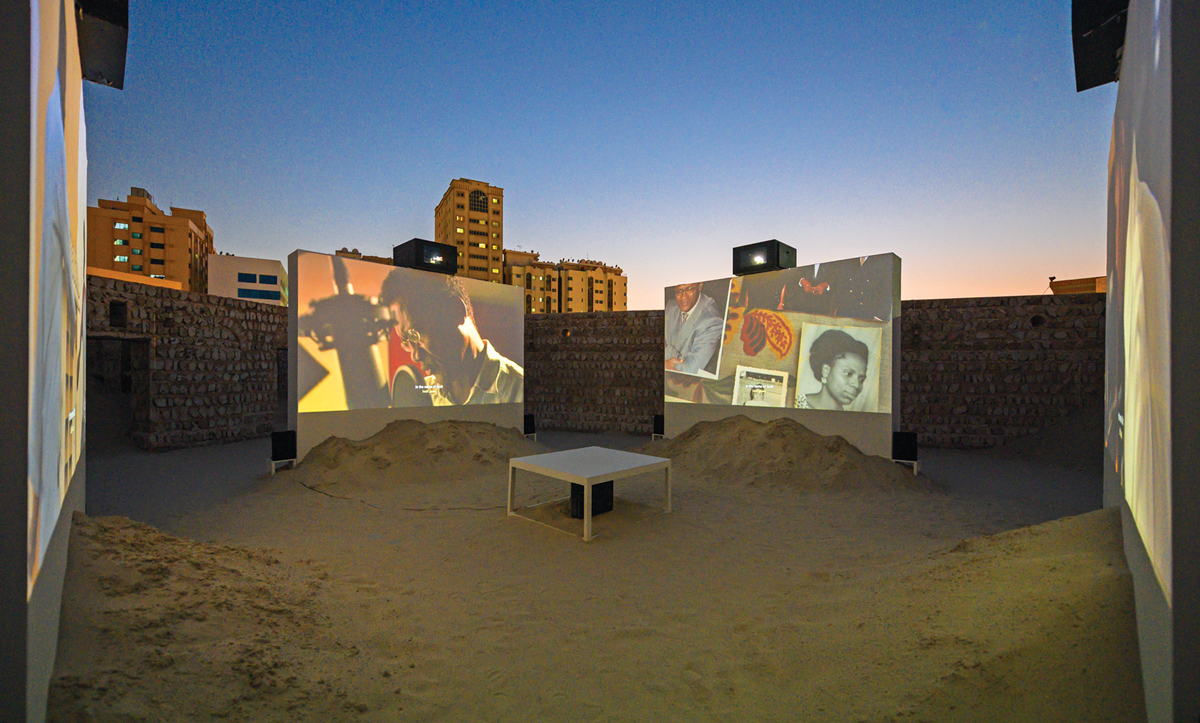
Tuan Andrew Nguyen, The Specter of Ancestors Becoming, 2019, four-channel video installation, mixed media, and sand, dimensions variable, installation view.
COMMISSIONED BY SHARJAH ART FOUNDATION, PRODUCED BY SHARJAH ART FOUNDATION WITH ADDITIONAL PRODUCTION SUPPORT FROM THE SAN FRANCISCO MUSEUM OF MODERN ART. COURTESY THE ARTIST, JAMES COHAN, NEW YORK, AND SHARJAH ART FOUNDATION
For a desert, Sharjah is an uncommonly fertile location for a biennial. There are countless untapped histories in the land and surrounding waters—and just as many suppressed ones.
Since the Sharjah Biennial began 26 years ago, the best works have been those that let the location do the heavy lifting, and the 14th edition, titled “Leaving the Echo Chamber” and curated by Zoe Butt, Omar Kholeif, and Claire Tancons, was no exception: of the 285 artworks included, 60 were commissions. One of these, from Kholeif’s section, won the biennial’s top prize—Otobong Nkanga and Emeka Ogboh’s installation Aging Ruins Dreaming Only to Recall the Hard Chisel from the Past, in which the artists reimagined a dead palm in a fallow garden as a tree addicted to saltwater. They surrounded the tree with cratered mounds filled with saltwater, colored in deep vegetal shades of carmine and ocher. Speakers played chirpy insect sounds and voices spoke commentary from the point of view of the trees or the earth itself, interspersed with the occasional Emirati rain song. Stepping into the courtyard felt like stepping out of time.
In a courtyard nearby was Tuan Andrew Nguyen’s four-channel installation, The Specter of Ancestors Becoming (2019), this piece an inclusion of Butt’s. Projected at dusk onto four unconnected walls, the film imagines the early days of the Senegalese-Vietnamese métis community, the product of French colonial soldiers bringing their Vietnamese brides home from war. The bases of the walls were piled high with sand, and their backs featured photographs, posters, and—somewhat spoiling the effect—an explanatory wall text.
One character in the film bristles at being referred to as a black Westerner, a figure that recurs throughout this edition of the biennial, most notably in Michael Rakowitz’s excellent stop-motion film The Ballad of Special Ops Cody, 2017 (another selection by Kholeif), which builds off a 2005 incident in which Iraqi insurgents attempted to secure the release of a crony in exchange for an American soldier’s life. Turned out it was a hoax: the “American soldier” in a photo the insurgents sent was the African-American version of an action figure. In Rakowitz’s video, a GI Joe toy sneaks into a museum display case to chat with some Mesopotamian statues—a gesture invoking shared humanity.
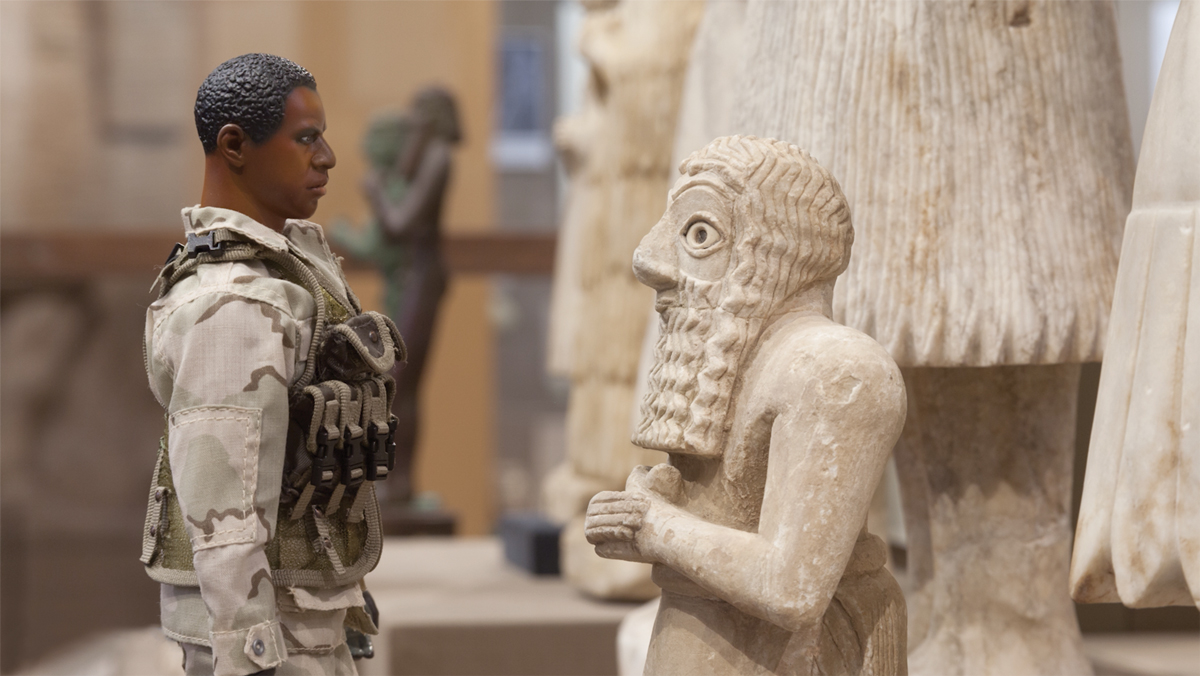
Michael Rakowitz, The Ballad of Special Ops Cody (still), 2017, video, 14 minutes, 42 seconds.
COURTESY JACK PERSEKIAN AND SHARJAH ART FOUNDATION/COLLECTION OF AL MA’MAL FOUNDATION FOR CONTEMPORARY ART / CONTEMPORARY ART MUSEUM PALESTINE. COMMISSIONED BY THE MUSEUM OF CONTEMPORARY ART CHICAGO
In response to the Faraday cage of mainstream media, Sharjah’s curators gave themselves certain mandates. They hoped to widen the scope of representation, consider the under-considered, and amplify connections and resonances across heterogeneous time periods and geographies. In short: art in the age of fake news, but made postcolonial.
This isn’t exactly novel; it’s pretty much what every event on the global biennial circuit is trying to do these days: move beyond the limitations of Eurocentric art history, and amplify the historically marginalized, which is to say, bring them to market. Works by many of Sharjah’s artists, including Nkanga, Huguette Caland, Shezad Dawood, and Meschac Gaba, were available for sale a week later in the booths at Art Dubai.
But Sharjah has several advantages over other events. First, it’s a state-sponsored biennial under the aegis of the emirate’s ruling family, with all the support and license that confers; this gave the Sharjah Art Foundation, which convenes the biennial, the ability to spend the last decade working with artists, institutions, and scholars in Eastern Africa, culminating in the recent opening of the Africa Institute. Second, Sharjah is part of a country in which some 90 percent of the population are citizens of other countries, the highest such figure in the world.
Last, and perhaps most important, for most of its history the UAE was too peripheral to register as more than a blip on the fringes of other empires; as a result, it’s a rare phenomenon: a part of the Global South that was never colonized. As such, it doesn’t suffer from the postcolonial hangover that dominates—and arguably stymies—the intellectual discourse of so many of its neighbors. The emirate’s post-Western-ness is driven by expedience, not ideology: if it’s currently making overtures to China and Nigeria and looking to shore up its ties to India and the Philippines, that’s a consequence of demographics and market, and not an anti-imperialist gesture or displaced nostalgia for the Bandung. All of this gave the biennial curators’ mandates additional resonance.
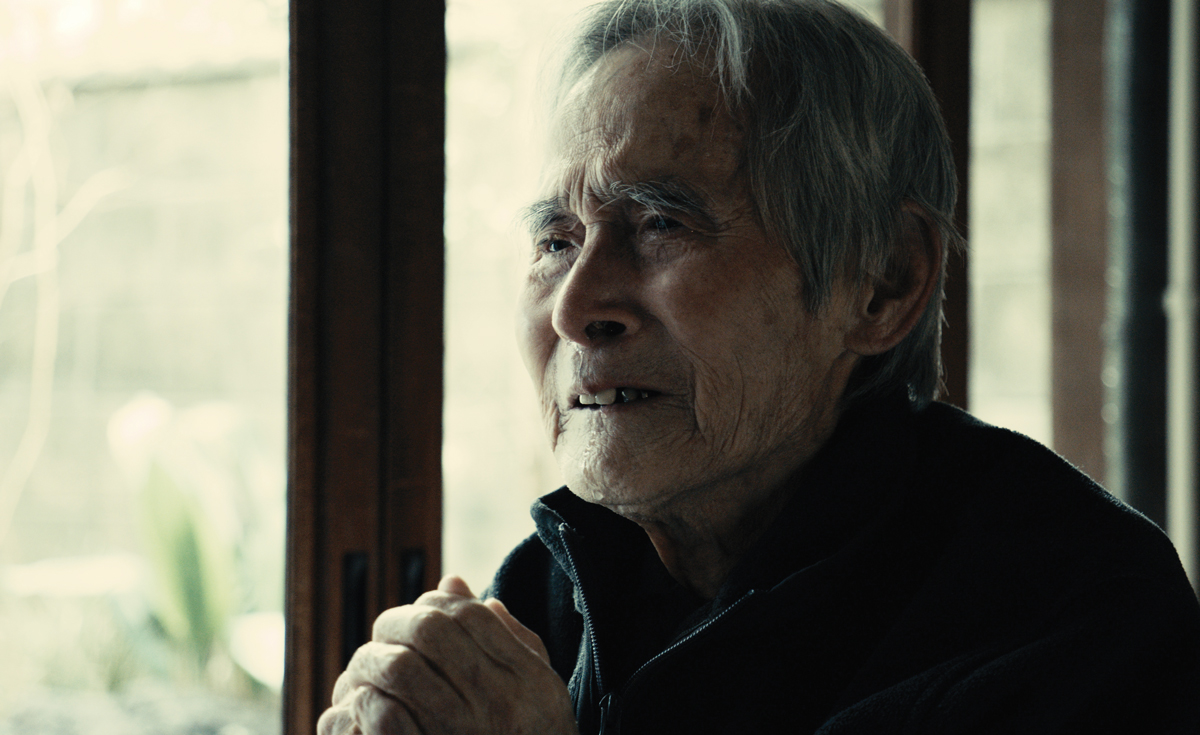
Meiro Koizumi, The Angels of Testimony (still), 2019, three-channel video installation with archival materials, duration and dimensions variable.
COMMISSIONED BY SHARJAH ART FOUNDATION. COURTESY THE ARTIST, ANNET GELINK GALLERY AND MUJIN-TO PRODUCTION
For this edition, each curator was responsible for what was essentially a show-within-a-show. These separate exhibitions were, curiously and somewhat confusingly, referred to as separate biennials. And so, given the three curators’ very different geographic and practical remits, this approach made the event as a whole a tantalizing Venn diagram to try to construct. The curators are about as miscible as oil and water, and the boundaries of each show were jealously policed, almost as if to forestall any possible synergies. The result was the kind of clashy, high-friction dialecticism that defines the UAE’s own wary multiracialism: low on politesse and often discordant, but certainly productive in its own way.
At its best, Butt’s effort, “Journey Beyond the Arrow,” sensitively excavated Indian Ocean histories. It emphasized Southeast Asia and indigenous knowledge and could be boiled down to the question, How should one be in a place? Several artists took up the subjects of Islam in the Malay Peninsula and Enrique of Malacca, a slave who circumnavigated the globe with Magellan. Roslisham Ismail’s exuberant, multivalent timeline of Yemeni migration to Malaysia, and Ampannee Satoh’s video of a tomb memorializing a massacre of Thai Muslims were especially poignant.
Two other standouts in Butt’s biennial were videos addressing Japanese colonialism. Phan Thao Nguyen’s soft, evocative Mute Grain (2019) revisits the 1945 famine in French Indochina; the occupying Japanese forces insisted farmers grow jute instead of grain, and two million people died, but the episode is largely elided in official narratives. Meiro Koizumi’s powerful three-channel installation The Angels of Testimony (2019) explores collective national guilt by having theater students reenact testimony from a Japanese war criminal. This footage plays on two screens that flank a central screen showing the former soldier, now an old man with Alzheimer’s, made to read and relive the atrocities that time had allowed him to forget.
But the subtlety of these works fought against a heavy-handed didacticism. Some of the exhibition labels here drew explicit links between proximal works, in a manner that suggested little confidence in the viewer. Accompanying Nguyen’s work were words printed on the wall: “This tension between official and unofficial histories can also be seen in the projects of Antariksa and Ahmad Fuad Osman in the neighboring galleries.”
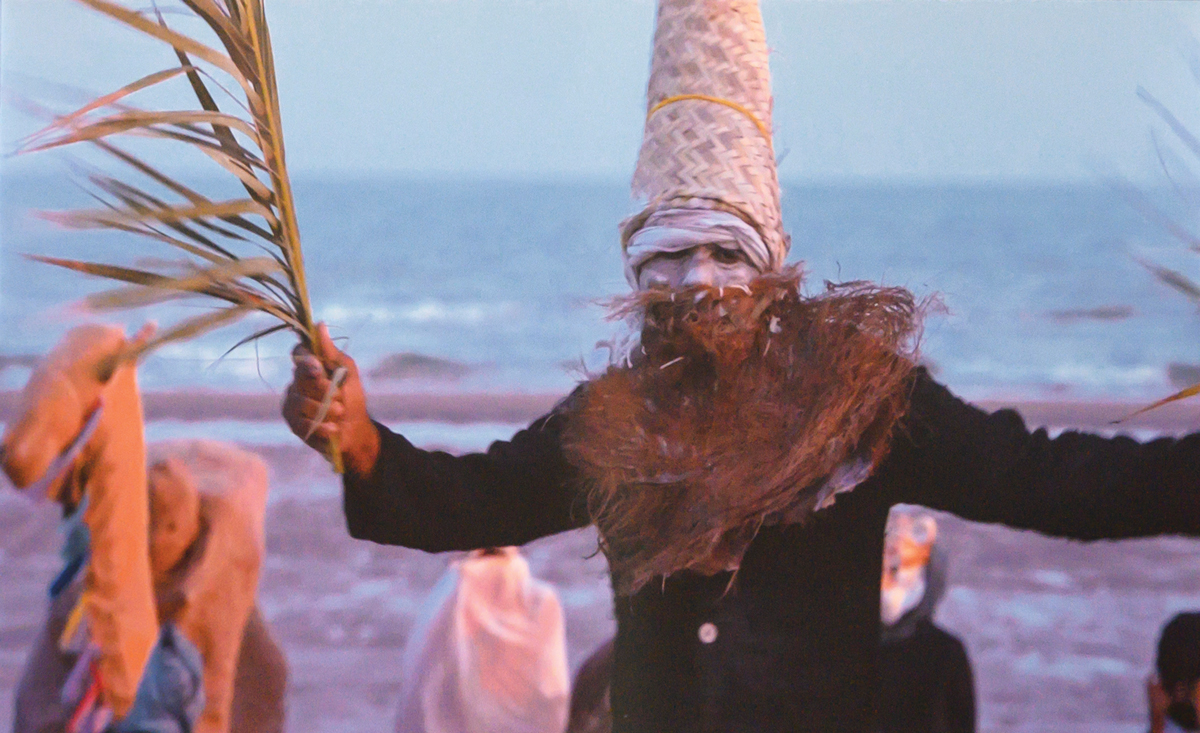
Alia Farid, At the Time of the Ebb (still), 2019, video loop, 21 minutes.
COMMISSIONED BY SHARJAH ART FOUNDATION. COURTESY THE ARTIST, GALERIE IMANE FARÈS, PARIS, AND SHARJAH ART FOUNDATION
Whereas Butt’s section came off as stern and Kholeif’s as a somber swansong—not “making new time,” per its title, so much as buying it (and it’s much needed)—Tancons’s, titled “Look for me all around you” after a documentary about Pan-Africanist movement leader Marcus Garvey, provided this biennial with its few moments of joy.
Tancons offered performance as a meditation on migration and diasporization: biennial as sun salutation. Many of the works were timed to coincide with solar rhythms, and “activated” only at specific times of day. One of the loveliest was Caline Aoun’s Time Travel (2019), which livestreamed the Beirut sunset every evening using four spinning projectors. The result was dreamy, a brief atmospheric, anosmic magic that was nevertheless redolent of jasmine. (If any through line emerges in this edition as a whole—fuzzily, like Aoun’s sunset—it’s that South-South might be a bankrupt concept, and Indian Ocean discourse, what I’ve come to think of as warm-water solidarity, might be one tentative way out.) Similarly gorgeous was another sunset ritual in Alia Farid’s video At the Time of the Ebb, 2019, which depicts the 600-year-old Nowruz-e Sayyad, or fishermen’s new year, celebration that takes place every summer on the Iranian island of Qeshm.
Tancons’s commissions were notable for their efforts to address the local context, and Mohau Modisakeng and Thembekile Komani’s performance, called The Land of Zanj, was a rare instance of site specificity in practice and not just in name. One afternoon in March some 76 miles away from Sharjah in the small city of Kalba on the Gulf of Oman, a two-part processional paid moving tribute to the complex history of East African migration to the Gulf, its title invoking both the Swahili Coast and the Zanj rebellion of 869–883, a slave revolt across the Gulf in Basra. (The Arab slave trade was only formally abolished in the 1960s and remains a touchy subject, even as the UAE’s racial hierarchy has been somewhat subsumed by a newer militarized national unity mandate.)
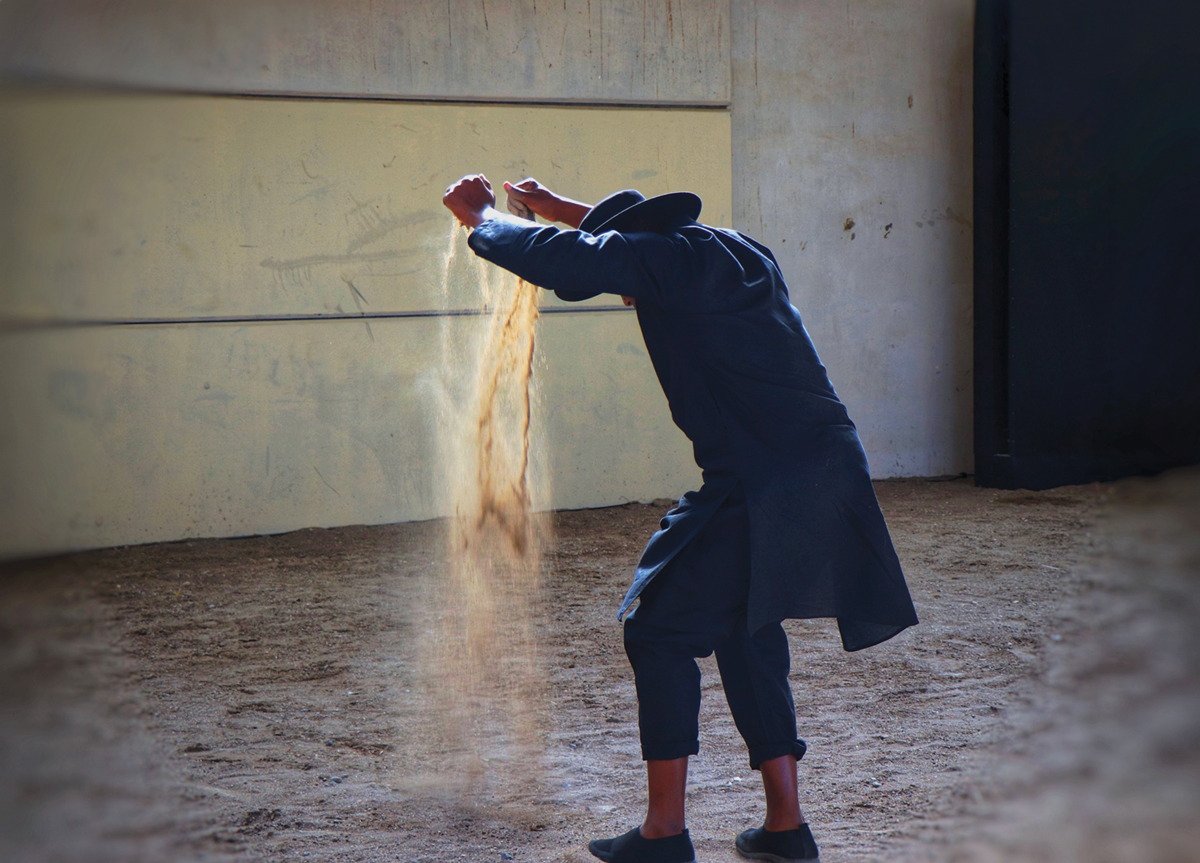
Performance view of Mohau Modisakeng and Thembekile Komani, The Land of Zanj, 2019.
COURTESY SHARJAH ART FOUNDATION
The 20 or so black-clad performers carried boats and chests as they walked, ran, and rolled down the beach, finally wading into the very same sea those sailors, pirates, and slaves would have come from. It was hard not to feel a certain exhilaration—saltwater drunk, like that gluttonous palm. But here there were no historical CliffsNotes provided. A valuable exercise in Glissantian opacity, perhaps, but it did mean that those unfamiliar with the context perceived little more than beautiful spectacle.
Also in Kalba—in the Kalba Ice Factory—was a performance by Isabel Lewis, Matthew Lutz-Kinoy, and Hacklander/Hatam, of which I caught the last half. It gestured toward the appropriative pitfalls of site specificity. At one point Lewis, dressed in the blue coveralls that primarily South Asian construction workers wear, headbanging in the dust, was circled by Emiratis in luxury sedans, like predators circling their prey. (The image came to mind again the next day in Sharjah, when I saw Xu Zhen’s The Starving of Sudan, 2008, its subject the infamous 1994 image of a vulture and a Sudanese child.)
Then again, when these works are staged only once, during a biennial’s opening week, to exist thereafter only as documentation, it feels less like performance art and more like VIP programming. I’m left thinking of a line from Anawana Haloba’s A Dragon King in Sleepy Pride Rock, 2019, an installation engaging with China’s inroads into Zambia: “A Westerner from the East is a friend indeed.”
A version of this story originally appeared in the Summer 2019 issue of ARTnews on page 106 under the title “Sharjah Biennial.”
[ad_2]
Source link

